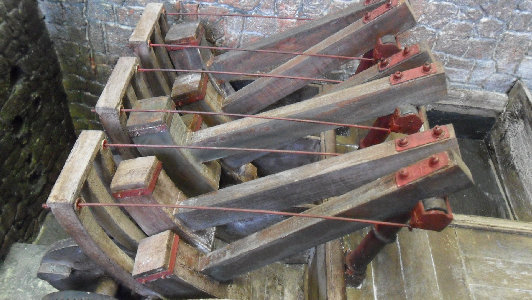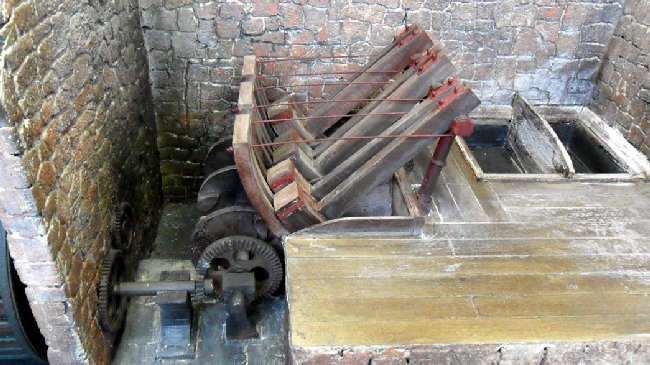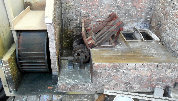FULLING MILL

Fulling consists of the closing together of the threads of newly woven woollen fabric with the end purpose of producing a grease free cloth of the correct thickness for future use, including dying. When woollen cloth has been first woven the fibres of its fabric will be loose and unmeshed and similar in texture to a piece of sackcloth.
Fulling was one of several processes involved in the production of woollen cloth, namely scouring and consolidation of the fibres of the fabric. Woven cloth straight from the loom has a rather open, loose texture and the woven threads needed closing or tightening. The fulling process consolidates and thickens the structure of the fabric by knitting the fibres together more thoroughly and by shrinking them which transforming the cloth into a more compact tight weave,
Scouring used river water direct from the leat and a soap cleaning agent was used to help rid the cloth of any natural oils and grease. This process involved the use of a number of different agents such as Fuller's earth, stale urine or soapwort, Fuller's earth, with its ability to absorb dark organic matter from oils and greases was particularly valued for its de-greasing and decolourizing properties. It is a non-plastic, fine clay, containing over half silica and it was from its use in the fulling process that it got its name.
Fulling was one of several processes involved in the production of woollen cloth, namely scouring and consolidation of the fibres of the fabric. Woven cloth straight from the loom has a rather open, loose texture and the woven threads needed closing or tightening. The fulling process consolidates and thickens the structure of the fabric by knitting the fibres together more thoroughly and by shrinking them which transforming the cloth into a more compact tight weave,
Scouring used river water direct from the leat and a soap cleaning agent was used to help rid the cloth of any natural oils and grease. This process involved the use of a number of different agents such as Fuller's earth, stale urine or soapwort, Fuller's earth, with its ability to absorb dark organic matter from oils and greases was particularly valued for its de-greasing and decolourizing properties. It is a non-plastic, fine clay, containing over half silica and it was from its use in the fulling process that it got its name.

After mixing water and the cleaning agent together, the cloth was pounded by heavy fulling stocks or beaters. The amount of fulling required for a particular cloth was part of the skill of the fuller. It depended on the type of wool, the type of water, the cloth texture, the temperature of the water and the time allowed under the fulling stocks. Care was needed to ensure the whole cloth received an equal, consistent beating, and skill was required to know when the cloth had been fulled sufficiently. Any lack of attention could lead to holes in the fabric and thus ruining a whole bolt of cloth. The first step, Sheep's wool being very greasy to handle, was to remove all traces of grease from the newly woven wool, and this would be done by smearing the cloth with soap,soda and covering with hot water, then trampling in a trough or washtub until all traces of oil or grease were removed. Then the actual fulling took place, with the cloth passing beneath the wooden mallets, usually three times. The first time the trough beneath the mallets contained urine, collected by the cask from the cottagers who received a penny a bucket. The second fulling was with the Fuller's earth and the third with hot soapy water. Each pounding lasted two hours, with a final thorough rinsing in clean water.



A set of six hammers which are lifted in sequence by the camwheels below, the action of the hammer dropping onto the cloth soaking in the liquid below forces the fibres to mesh together, the mechanism of the model actually works if the camshaft is turned anticlockwise
Above: showing the gearing off the main shaft, this was necessary in order to show the mechanism clearly with the cam wheels parallel to the mill wheel which is to the left behind the wall.

1/12th Scale